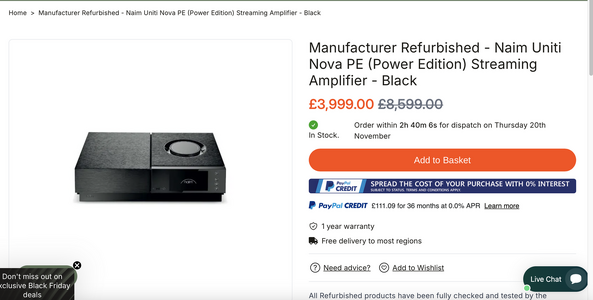As the Naim doesn't have any room correction, I'd have certainly tried the Lyngdorfs without correction first - making a like for like comparison of the actual products to get an idea of how they stack up against each other before messing about with room correction. After that, tinker away, but make sure the product is a quality product before messing with something that will improve how it sounds.
And off the back of that, he states he heard one Lyngdorf with correction and one without. Presuming they do have a similar sound signature (not a guarantee, but possible), why did he not hear a significant difference between the two? Surely this supposed top class room correction should make quite a noticeable impact? If it didn't, that either means it's "not all that", or the measurements weren't conducted properly - either through inexperience, accident, or to intentionally make the Naim sound better. If he didn't witness the measurement process, he has no guarantee the measurements are even for that room or speakers.
Hi David,
When it comes to RoomPerfect, I can only assume the team at Audio T knew what they were doing during setup. The software was used on one of the two Lyngdorf units, and while I did notice differences and some improvement, it wasn’t the huge leap in performance I’d expected. Yes, the changes were audible, but perhaps expectations play a big role here and these are often set by articles where testing has been looked at .
From what I’ve read, Lyngdorf’s room correction is considered among the best available — and it’s entirely possible that, in my own home, the results might have been quite different. Still, as a first-time listener to their products, I found that while both units brought sonic improvements, there was also a trimming of the higher frequencies that didn’t quite suit my taste.
Afterward, the team at Audio T explained that further adjustments could be made through the app — with around a dozen sound profiles and even deeper settings available if you dig deeper. That level of flexibility will appeal to some, but for me, it came a bit late in the process. By that point, I’d already listened to the Naim, and to my ears, its sonic performance took a clear step forward across the frequency range, especially in the upper registers.
Had the difference between the two Lyngdorfs been as striking as the difference between them and the Naim, I’d have been taking one home to try without hesitation.
The app, though powerful, adds a level of complexity I don’t particularly want. Some enjoy fine-tuning for each recording or genre — I just want to sit back and enjoy the music, not tweak settings every time I listen.
I also wanted to connect my TV through whichever network streamer I chose. The Naim includes this capability out of the box, whereas the Lyngdorf requires an additional unit (around £500, from what I was told). Not a deal breaker, but worth noting.
On top of that, the TDAI-2210 is currently on back order — Audio T doesn’t have any available, and the Lyngdorf/Dali rep said about 60 units are already ordered in this area with no confirmed delivery date. Clearly, these are popular products — and I can see why. They’re well-built, understated, and of obvious quality. But for me, as things stand, something in their sound just didn’t click the way the Naim Nova PE did.


